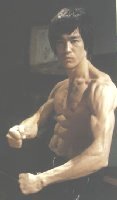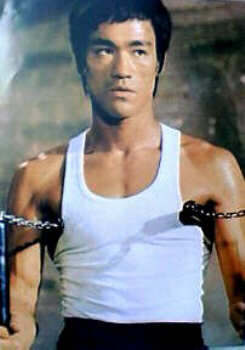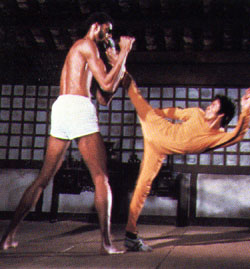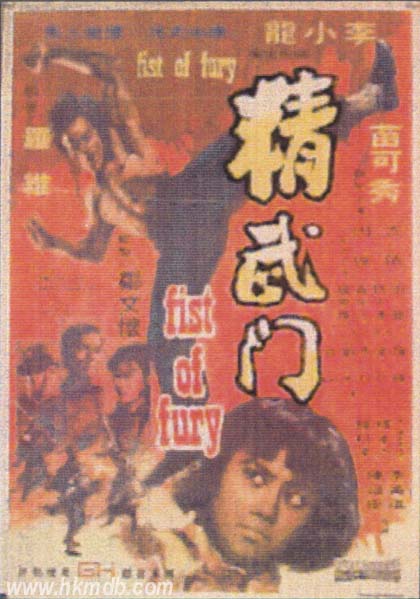



|
|
Lee Jun Fan was born November 27, 1940 (the Year of the Dragon according to the Chinese calendar). Since he was born in San Francisco, his parents wanted to also give him an "American" name. It would be this name by which Fan would become known worldwide -- Bruce Lee. The Lee family soon moved back to their native Hong Kong, where the young Bruce began appearing in films.
As a teenager, Lee began to seriously study the martial arts, mostly as a way to impress women. Even at a young age, Lee was quite the ladies' man. He was charming, intelligent and a good dancer, even winning a few dance championships. But he also had a great ego and would not take "no" for an answer. If he saw a girl he liked who happened to be accompanied by a boyfriend, Bruce would not hesitate to put his fists to use. Rumors about Lee at this time have him beating up whole groups of Triads and U.S. Navy members just to impress one girl. At any rate, the constant fighting and carousing was worrying Lee's parents, so they sent him back to America with only a few hundred dollars (the Lee family's life savings) to his name.
Lee worked odd jobs for family members, mostly as a cook or dishwasher in restaurants. Though he was still getting into trouble with the ladies, Bruce began to calm down somewhat and began to study all sorts of martial arts and philosophy. Seeing that without a formal education, he would never rise above the menial jobs he was doing, Lee eventually moved to Seattle to attend college. To pay for tuition, Lee began teaching a few students kung-fu. Eventually, word spread around campus and he had enough students to open his own school, where he developed his own style of fighting, Jeet Kune Do ("the way of the intercepting fist").
To promote his school, Lee traveled around giving demonstrations of Jeet Kune Do and his considerable physical skills, such as being able to do two-fingered push-ups. Lee also showcased his (now) famous "one-inch punch," where he could punch someone from only one inch away, yet still have enough force to send them back several feet. The demonstrations were often filmed, and one of these films found its way to a television producer named William Dozier, who hired Lee for the TV show The Green Hornet as Kato. Even though he was cast as the sidekick, Lee was the real star of the show. He would often improvise his own stunts and fight sequences, some of which would move so fast that the directors would tell Bruce to slow down. Lee's reputation got to be so much that when he fought Burt Ward (Robin) during a Batman tie-in episode, people were worried that Ward might be seriously hurt. As outstanding as Lee was, The Green Hornet lasted only one season.
William Dozier, seeing that Lee had incredible potential, started to develop a new series with the budding star -- Kung Fu. However, network executives thought Lee looked too "oriental" to star in a series and thus gave the lead to a white actor (David Carradine, who is still milking the role to this day). Disgusted with Hollywood (and wanting to spend more time with his newborn son, Brandon) Lee returned to Seattle to concentrate on his school.
While The Green Hornet failed in America, it became a huge hit in Hong Kong. Movie producers began to contact Lee to star in movies, but it was Raymond Chow (the head of the upstart Golden Harvest studio) that convinced Lee to come back to Hong Kong. Lee's first Golden Harvest movie The Big Boss (aka Fists of Fury) was a huge hit, and his next, Fist of Fury (aka The Chinese Connection), was even bigger. In about a year, Bruce Lee became Asia's biggest draw. Lee was shrewd financially; he knew if his movies were making a lot of money, he should be making a lot of money too. So he created his own production company, Concord Productions. While not unusual for America, this was a major step for Asian stars, as most studios still operated under the classic "Hollywood system" (where key actors and directors were kept under contracts to one studio, only receiving a small -- if any -- part of the profit their movies made). Not only was Lee becoming a legend in front of the camera, he was also breaking new ground behind it as well.
His next film, The Way of the Dragon, was another runaway hit in Asia. By this time, western movie studios (who beforehand had considered kung-fu movies "unintelligible" to western audiences) began to notice the huge amount of money Lee's movies were making. While working on Game of Death (which would become his final film, completed using a stunt double after Lee's death), Lee was contacted by the Warner Brothers studio to star in Enter the Dragon. Sporting a large budget and a talented international cast, Enter the Dragon was a smash hit worldwide, made Lee an international star and would set the standard for martial arts films for years to come.
Unfortunately, Lee never saw any of this. On July 20, 1973 -- shortly before Enter the Dragon's premiere -- Lee died suddenly of a brain aneurysm. Rumors circulated wildly about the circumstances of Lee's death. Some said he overdosed on hashish, while others suspected other martial arts masters who were angry at Lee for teaching kung fu to westerners. The most reasonable explanation is that Lee has an allergic reaction to a pain pill given to him by an actress. Whatever the reason, Lee's death sent shockwaves through the Hong Kong movie industry. Almost overnight, dozens of imitators popped up, sporting names like Bruce Li, Bruce Lie and Bruce Lay. Audiences weren't fooled -- none of the Lee pretenders' movies did well.
Some 25 years after his death, Bruce Lee still holds a magical fascination with moviegoers. Even though he produced only a handful of movies, Lee's legacy lives on in the hearts and minds of martial arts fans all around the world.